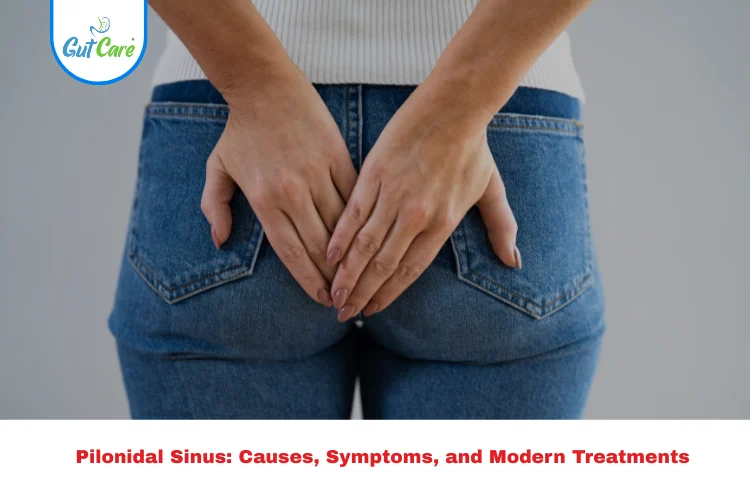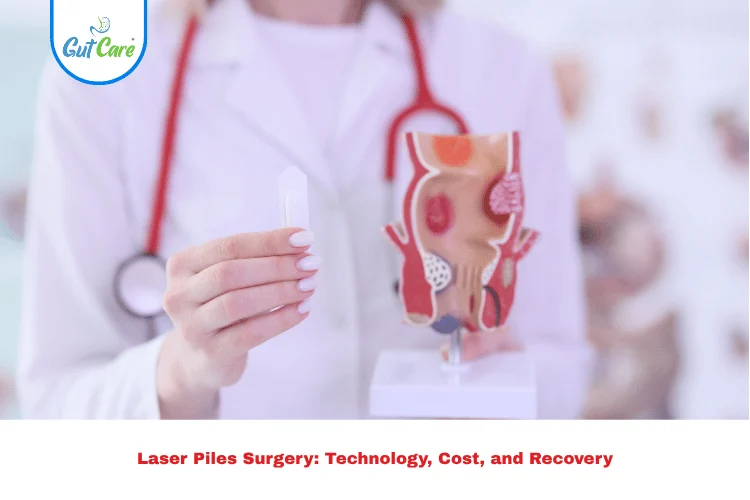Looking for a lasting remedy for pilonidal sinus? At Gutcare Clinics, a leading name in Bangalore for more comprehensive colorectal care, we provide the most modern management of pilonidal sinus, including laser surgery. The expert in this field is Dr. Yuvraj Singh Gehlot our piles specialist. In this blog, we will outline what a pilonidal sinus is, the causes, the symptoms and how to get rid of it.
Understanding Pilonidal Sinus
A pilonidal sinus is a small tunnel or cyst that forms in the skin near the tailbone (the coccyx) at the top of the crease between your buttocks. Typically, a pilonidal sinus will contain hair, debris, and pieces of skin. When this sinus becomes infected, it can be extremely painful, as well as result in pus or blood discharge.
Pilonidal sinus disease is most common in young men who sit a lot, for instance, drivers or IT professionals. If it continues to go untreated, you may develop recurrent abscesses and infections that greatly impact your daily life.
Causes of Pilonidal Sinus
The development of a pilonidal sinus is typically linked to the following causes:
1. Ingrown Hair
When the direction of hair grows inwards, rather than out of the skin, it may penetrate the skin, forming a sinus tract. The body will form a cyst or abscess, in reaction.
2.Friction and Pressure
Extended periods of time spent sitting, especially on hard surfaces increases pressure on the area of the tailbone, leading towards hair penetration. In addition, there’s pressure from your body weight, too, that increases the possibility of infection.
3. Poor Hygiene
Poor cleanliness within the sacrococcygeal region of the body can create a chance for buildup of debris and skin infections.
4. Heat and Excessive sweating
Heavy and hot environments serve as an ideal breeding ground for bacteria, and too much sweating can lead to greater chance of developing an infection with inflammation.
5. Obesity
Excessive weight or obesity may have a role in the depth of the buttock cleft, creating an area suitable for hair entrapment in addition to creating an environment for bacteria activity.
6. Hereditary
People may have a gene to develop a condition/similar condition as they may inherit a potential risk.
Symptoms of Pilonidal Sinus
Signs of pilonidal sinus disease can be varied depending on the specific severity. An individual may have silent sinus, meaning that there might be no symptoms for months. When the disease gets infected, below are the signs that usually happen:
1. Pain near the tailbone, especially when sitting and walking
2. Swelling or tender lump in the upper buttock crease
3. Redness and warmth around the area
4. Foul smelling pus or bloody drainage
5. You can see sinus openings or holes directly on the skin
6. Fever or generalized sickness in advanced infections
If you have persistent or recurrent symptoms, you should seek medical intervention.
Diagnosis: When to See a Doctor
If you have any of these symptoms, you should contact a medical professional. Steps to diagnose typically involve:
Physical Assessment: This could be an observation and/or a physical exam of the affected area.
Imaging: In cases of recurrence or complicated issues, imaging using ultrasound or MRI may be used to check on the sinus tracts.
Treatment Options for Pilonidal Sinus
1. Conservative Management Back to Top
In the early stages, or in the absence of infection, conservative management may be beneficial:
– Antibiotic therapy: Antibiotics can help to control the infection, but do not kill the sinus.
– Hygiene steps: Keeping the area clean and dry.
– Removal of hair: Afro’s, depilatory creams, or lasers can be helpful in avoiding recurrence.
– Warm compresses: to lessen swelling and pain.
– Note: These methods will only provide temporary symptom relief, and will not eliminate the underlying disease.
2. Incision and Drainage (I&D)
When a painful abscesses occurs, a small, minor surgery, is performed to:
– Cut a small opening to access the infected pus.
– Relieve the pain and lessen the level of infection.
– Allow the body to heal naturally with time.
– This approach is often left to emergency situations, but will not prevent recurrence.
3. Surgical Excision
– The surgical approach is recommended in chronic or recurrent cases when complete removal of the sinus tract is required.
Type of Surgery
Open Excision (secondary intention healing): the sinus is excised, and the wound left open for natural healing to occur.
Closed Excision (primary closure): The sinus is excised and the incision is sutured for quicker recovery.
Flap surgery: repositioning the skin to close the defect and relieve tension, which is associated with reduced recurrence.
4. Laser Treatment for Pilonidal Sinus (LPS)
The most advanced and easiest way to treat your problem.
At Gutcare Clinics, we have pioneered laser treatment for pilonidal sinus, resulting in:
- Minimal invasive
- No stitches or hospital
- Minimal pain and bleeding
- Return to normal life quickly
- Reduce recurrence rates
Dr. Yuvraj Singh Gehlot, our lead piles specialist, recommends this procedure for patients who want a safe, effective, and modern solution.
Why Choose Gutcare Clinics, Bangalore?
If you are dealing with pilonidal sinus in Bangalore, Gutcare Clinics is your trusted destination. Here’s why:
- Qualifications of Dr. Yuvraj Singh Gehlot, an exceptionally skilled piles specialist and laser surgeon
- State-of-the-art technology, including advanced laser technology
- Clean, updated facility to promote patient safety
- Patient-focused care and personalized recovery, tailored to your needs.
We are here for your journey with you every step of the way, from consultation to post-treatment support, so you can live pain-free.
Final Thoughts
Although it may seem insignificant, a pilonidal sinus can be a relatively minor issue that evolves into a significant source of pain and discomfort if not managed appropriately. With early detection, effective hygiene, and the new range of modern treatments (including laser surgery), you can expect to make a full recovery and avoid further complications.
If you or a loved one are experiencing symptoms associated with a pilonidal sinus, don’t hesitate to book an appointment.
Dr. Yuvraj Singh Gehlot at Gutcare Clinics, which is a trusted centre for piles and other colorectal issues in Bangalore, is here to alleviate your symptoms and get you back on the road to recovery.
We care about your health!
FAQs About Pilonidal Sinus
1. What is the cause of pilonidal sinus?
A pilonidal sinus comes from an ingrown hair, and friction over the tailbone area. Sitting for prolonged periods, poor hygiene, and excess weight can all increase the risk of pilonidal sinuses.
2. Does a pilonidal sinus heal naturally?
While it is possible for early-stage sinuses to settle down for a while, on the whole they will require treatment of some kind to avoid reoccurrence. Laser surgery is a highly recommended treatment.
3. Is laser treatment successful for pilonidal sinus?
Absolutely! Laser treatment is minimally invasive, painless, and an attractive alternative to regular surgery, and faster recovery times and less reoccurrence is an additional benefit.
4. Which doctor is the best for pilonidal sinus in Bangalore?
Dr. Yuvraj Singh Gehlot at Gutcare clinics in Bangalore is a top piles specialist and a leading expert on pilonidal sinuses and laser surgery for other colorectal disorders.
5. Why is Gutcare clinics the best hospital for pilonidal sinus?
Gutcare clinics need nothing but the most advanced treatment, including Laura surgery, by the top specialists, including Dr. Yuvraj Singh Gehlot. Gutcare Clinics in Bangalore is a specialist that is known for excellence, hygiene, and patient satisfaction.




